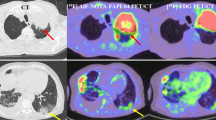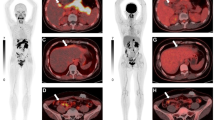Summary
BACKGROUND: Especially advanced stages of non-small cell lung cancer are often considered a diagnostic and staging dilemma. METHODS: Review of recent literature. RESULTS: Today the operability of lung cancer is decreasingly determined by technical aspects related to the primary tumour (resectability), but rather by oncological considerations (operability). Histological verification is usually achieved endoscopically in centrally located tumours and by CT-guided needle biopsy in periphereal lesions. Modern spiral CT enables very reliable judgement to be made concerning malignant infiltration of surrounding anatomical structures and enlarged mediastinal lymph nodes stations. However, the predictive value of CT in evaluating mediastinal lymph node is still limited. Positron emission tomography (PET) has a negative predictive value in this respect of 91–99%, whereas the positive predictive value is presently not more than 40–60%. Hence, further surgical verification through mediastinoscopy is necessary in the latter cases. Diagnostic approaches to proper staging of the T, N and M aspects of the disease as well as estimation of functional operability through preoperative pulmonary function analysis are discussed in detail. CONCLUSIONS: Proper diagnostic algorithms at evidence of lung cancer are of crucial importance because any therapeutical measures and prognoses strongly depend on the clinical stage.
Zusammenfassung
GRUNDLAGEN: Im Zusammenhang mit fortgeschrittenen Stadien des nicht kleinzelligen Lungenkarzinoms wird gerne von einem Staging-Dilemma gesprochen. METHODIK: Zusammenfassung der aktuellen Literatur. ERGEBNISSE: Die Operabilität von Lungenkrebs wird heute in immer geringerem Maß von technischen Aspekten im Bezug auf den Primärtumor (Resektabilität), sondern viel mehr von onkologischen Überlegungen bestimmt. Die histologische Abklärung wird bei eher zentraler gelegenen Tumoren gewöhnlich über eine Bronchoskopie, bei peripherer Lage des Herdes mittels CT-gezielter Nadelbiopsie angestrebt. Moderne Spiral-CT-Techniken erlauben eine sehr gute Beschreibung der lokalen Tumorbeziehungen zu Nachbarstrukturen. Der prognostische Wert der CT in der Dignitätsbeurteilung der mediastinalen Lymphknotenstationen ist jedoch beschränkt, wobei hier die Positronen-Emissions-Tomografie (PET) deutliche Vorteile bietet. Der negative prognostische Wert dieser Untersuchung liegt mit 91–99 % im Bereich einer chirurgischen Abklärung, wobei der positive prognostische Wert um 40–60 % liegt. Bei suspektem PET-Befund im Mediastinum muss daher eine weitere Abklärung mittels Mediastinoskopie erfolgen. Das diagnostische Vorgehen zur korrekten Beurteilung der T-, N- und M-Aspekte der Erkrankung sowie die Abschätzung der funktionellen Operabilität mittels Lungenfunktion werden im Detail besprochen. SCHLUSSFOLGERUNGEN: Geeignete diagnostische Algorithmen bei Verdacht auf Lungenkarzinom sind von entscheidender Bedeutung, da alle therapeutischen Schritte und die Prognose weitgehend vom klinischen Stadium der Erkrankung bestimmt werden.
Similar content being viewed by others
Author information
Authors and Affiliations
Corresponding author
Rights and permissions
About this article
Cite this article
Getman, V.V., Mueller, M.R. Diagnosis, staging and functional operability of lung cancer. Eur Surg 36, 70–74 (2004). https://doi.org/10.1007/s10353-004-0040-4
Issue Date:
DOI: https://doi.org/10.1007/s10353-004-0040-4




